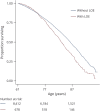Mortality in Patients With Late-Onset Epilepsy: Results From the Atherosclerosis Risk in Communities Study
- PMID: 34282048
- PMCID: PMC8456359
- DOI: 10.1212/WNL.0000000000012483
Mortality in Patients With Late-Onset Epilepsy: Results From the Atherosclerosis Risk in Communities Study
Abstract
Background and objectives: To determine the risk of mortality and causes of death in persons with late-onset epilepsy (LOE) compared to those without epilepsy in a community-based sample, adjusting for demographics and comorbid conditions.
Methods: This is an analysis of the prospective Atherosclerosis Risk in Communities study, initiated in 1987-1989 among 15,792 mostly Black and White men and women in 4 US communities. We used Centers for Medicare & Medicaid Services fee-for-service claims codes to identify cases of incident epilepsy starting at or after age 67. We used Cox proportional hazards analysis to identify the hazard of mortality associated with LOE and to adjust for demographics and vascular risk factors. We used death certificate data to identify dates and causes of death.
Results: Analyses included 9,090 participants, of whom 678 developed LOE during median 11.5 years of follow-up after age 67. Participants who developed LOE were at an increased hazard of mortality compared to those who did not, with adjusted hazard ratio 2.39 (95% confidence interval 2.12-2.71). We observed excess mortality due to stroke, dementia, neurologic conditions, and end-stage renal disease in participants with compared to without LOE. Only 4 deaths (1.1%) were directly attributed to seizure-related causes.
Conclusions: Persons who develop LOE are at increased risk of death compared to those without epilepsy, even after adjusting for comorbidities. The majority of this excess mortality is due to stroke and dementia.
Written work prepared by employees of the Federal Government as part of their official duties is, under the U.S. Copyright Act, a “work of the United States Government” for which copyright protection under Title 17 of the United States Code is not available. As such, copyright does not extend to the contributions of employees of the Federal Government.
Figures


References
-
- Josephson CB, Engbers JDT, Sajobi TT, et al. . Towards a clinically informed, data-driven definition of elderly onset epilepsy. Epilepsia. 2016;57(2):298-305. - PubMed
-
- Cloyd J, Hauser W, Towne A, et al. . Epidemiological and medical aspects of epilepsy in the elderly. Epilepsy Res. 2006;68(suppl 1):S39-S48. - PubMed
Publication types
MeSH terms
Grants and funding
- K24 AG052573/AG/NIA NIH HHS/United States
- HHSN268201700001I/HL/NHLBI NIH HHS/United States
- HHSN268201700004I/HL/NHLBI NIH HHS/United States
- U01 HL096902/HL/NHLBI NIH HHS/United States
- U01 HL096899/HL/NHLBI NIH HHS/United States
- HHSN268201700003I/HL/NHLBI NIH HHS/United States
- U01 HL096814/HL/NHLBI NIH HHS/United States
- U01 HL096917/HL/NHLBI NIH HHS/United States
- HHSN268201700002I/HL/NHLBI NIH HHS/United States
- U01 HL096812/HL/NHLBI NIH HHS/United States
- K23 AG063899/AG/NIA NIH HHS/United States
- HHSN268201700005I/HL/NHLBI NIH HHS/United States
